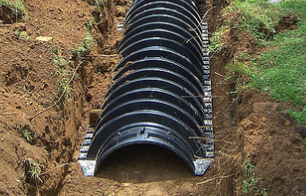Septic Systems - What to Do after the Flood
Published on by Water Network Research, Official research team of The Water Network in Academic
Do you have questions about how septic systems work? Do you know how to properly maintain your septic system? Here is what EPA suggests.

What do I do with my septic system after the flood?
Once floodwaters have receded, there are several things homeowners should remember:
- Do not drink well water until it is tested. Contact your local health department.
- Do not use the sewage system until water in the soil absorption field is lower than the water level around the house.
- Have your septic tank professionally inspected and serviced if you suspect damage. Signs of damage include settling or an inability to accept water. Most septic tanks are not damaged by flooding since they are below ground and completely covered. However, septic tanks and pump chambers can fill with silt and debris, and must be professionally cleaned. If the soil absorption field is clogged with silt, a new system may have to be installed.
- Only trained specialists should clean or repair septic tanks because tanks may contain dangerous gases. Contact your health department for a list of septic system contractors who work in your area.
- If sewage has backed up into the basement, clean the area and disinfect the floor. Use a chlorine solution of a half cup of chlorine bleach to each gallon of water to disinfect the area thoroughly.
- Pump the septic system as soon as possible after the flood. Be sure to pump both the tank and lift station. This will remove silt and debris that may have washed into the system. Do not pump the tank during flooded or saturated drainfield conditions. At best, pumping the tank is only a temporary solution. Under worst conditions, pumping it out could cause the tank to try to float out of the ground and may damage the inlet and outlet pipes.
- Do not compact the soil over the soil absorption field by driving or operating equipment in the area. Saturated soil is especially susceptible to compaction, which can reduce the soil absorption field's ability to treat wastewater and lead to system failure.
- Examine all electrical connections for damage before restoring electricity.
- Be sure the septic tank's manhole cover is secure and that inspection ports have not been blocked or damaged.
- Check the vegetation over your septic tank and soil absorption field. Repair erosion damage and sod or reseed areas as necessary to provide turf grass cover.
Find out more from the EPA's document in the attachement
Source: EPA
Media
Taxonomy
- Technology
- Risk Assessment
- Sewage
- Septic Tank
- Flood management
- Flood damage
- Flood Risk Management
- Waste Management
2 Comments
-
Hello: the septic system has of septic as the name. Storage of feces in a closed environment triggers a strong metahnisation of the middle that comes immediately into putrefaction. There is more no life of micro organisms in oxygen. It must drain the contents of the pit and transfer the levy to the station giving the same proportion of mud that came out. We see no trace of purification treatment, simple management of excreta and transferred the place of defecation to the place of their dispersion into the environment in a disguised form. A similar configuration to the defecation in the open air of a thousand years back
-
I see the EPA is still using the ops manual from the 1950,s. Provide lots of jobs and bankrupt the homeowner. Start using RNA microbes in all septic tanks. No need to pump out ever again. No water quality tests to pay for. No inspections from non qualified agencies. Septic tank microbial maintenance is 50 to 80 cents a month depending on the size of your tank. Many other advantages.